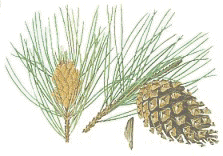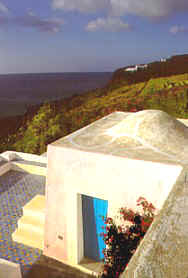What to Visit in Pantelleria island
 The 'Montagna
Grande': natural park and green
heart of the island, home of near 600 endemic botanic species, including the Limonium Cosyrese, the Helichrysm
Errarae and the Mattiola Incana.This park is also the only nesting place in Europe of the so graceful and
highly colored Cinciarella Algerina and Beccamoschino. At sunset, from the 'Montagna Grande', the sight of the Sicilian
Channel, with an occasional view of the African coast, is spectucular. The farming villages: groups of 'dammusi' with their 'giardini', enclosures for citrus fruit trees,
shltered from the wind by their partcular lava-stone walls. There are 11 villages located all over the island; they
still use their original Arab names, Khamma, Rekhale, Bukkuram, Bugeber... The 'Specchio di Venere': this tiny lake, of volcanic origin and of outstanding colors, is fed by
thermal springs: Not only does
it offer plenty of possibilities for water sports and fango therapy, in spring and autumn
it becomes a natural observatory for many species of migratory birds. The 'Khagiar': an exuberant vegetation of
mediterranean bush, made up of myrtle, arbutus, lentl and heather, grows low to the
ground, shaped into fantastic forms by the wind, on an ancient lava flow, 3 kilometers
long. A great number of wild rabbits live here, as well as the so-called Greek
turtle. 'Dietro Isola': the southern part of the island, where there is a pine wood (Aleppo,
Maritime), challenging the sea from the cliffs. An explosion of scents persist in this
continuation of the forest of the 'Montagna Grande'.'Salto la
Vecchia':these cliffs of the unforgettable name rise 300
meters above the sea,offering a spectacular panorama. Several species of birds nest in
them. The 'Piana di Ghirlanda':
this fertile plain, sheltered from the winds by the surrounding ancient volcanoes, is
considered the garden of the island. After some searching, bizantine
tombs can be found carved The 'Montagna
Grande': natural park and green
heart of the island, home of near 600 endemic botanic species, including the Limonium Cosyrese, the Helichrysm
Errarae and the Mattiola Incana.This park is also the only nesting place in Europe of the so graceful and
highly colored Cinciarella Algerina and Beccamoschino. At sunset, from the 'Montagna Grande', the sight of the Sicilian
Channel, with an occasional view of the African coast, is spectucular. The farming villages: groups of 'dammusi' with their 'giardini', enclosures for citrus fruit trees,
shltered from the wind by their partcular lava-stone walls. There are 11 villages located all over the island; they
still use their original Arab names, Khamma, Rekhale, Bukkuram, Bugeber... The 'Specchio di Venere': this tiny lake, of volcanic origin and of outstanding colors, is fed by
thermal springs: Not only does
it offer plenty of possibilities for water sports and fango therapy, in spring and autumn
it becomes a natural observatory for many species of migratory birds. The 'Khagiar': an exuberant vegetation of
mediterranean bush, made up of myrtle, arbutus, lentl and heather, grows low to the
ground, shaped into fantastic forms by the wind, on an ancient lava flow, 3 kilometers
long. A great number of wild rabbits live here, as well as the so-called Greek
turtle. 'Dietro Isola': the southern part of the island, where there is a pine wood (Aleppo,
Maritime), challenging the sea from the cliffs. An explosion of scents persist in this
continuation of the forest of the 'Montagna Grande'.'Salto la
Vecchia':these cliffs of the unforgettable name rise 300
meters above the sea,offering a spectacular panorama. Several species of birds nest in
them. The 'Piana di Ghirlanda':
this fertile plain, sheltered from the winds by the surrounding ancient volcanoes, is
considered the garden of the island. After some searching, bizantine
tombs can be found carved in the rocks of a peaceful, small wood. The lava-stone walls: the typical agricultural
architecture is rendered by the vast network of stone fences, which create cultivable terraces on the sides of volcanoes all over
the island. The 'cantine': the
many cellars where the famous 'Moscato' and 'Passito'
are produced. The caper Co-op:
where the so tasty capers are processed and sold. The 'Bagno
Asciutto': literallythe dry bath, but one is far from dry
after a few minutes in this natural sauna, a beautiful cave, seemingly lost in a tumble of
rocks near a mountain path: The bathing spots along the coast: Karuscia, Campobello, Khattibuali, Cala
Cinque Denti , Cala Gadir with its thermal springs, Cala Tramontana, the Faraglione,
Cala Levante, the incredible Arco dell'Elefante, Pantelleria's natural
monument (legend would have it that when the island lacks water the elephant pumps it in
from the sea....). The tour continues with the Cala Rotonda, the Balata dei Turchi and its obsidian cave, Nicŕ, where the thermal springs are at almost 100°C, the ancient Roman port
of Scauri, the thermal baths of Sateria, Suvaki, Punta Fram
with its fantastically sculpted lava forms, Mursia and the Cala Bue Marino. And absolutely not to be missed: a boat trip around the island , not
only for a different view of it, but also to visit the numerous marine caves, some as vast as cathedrals,
where the colors of the sea play from deep blue to emerald green. The smaller boats weave
in and out of these caves; one can also lower the anchor and dive in for a closer view of the beautiful underwater life. in the rocks of a peaceful, small wood. The lava-stone walls: the typical agricultural
architecture is rendered by the vast network of stone fences, which create cultivable terraces on the sides of volcanoes all over
the island. The 'cantine': the
many cellars where the famous 'Moscato' and 'Passito'
are produced. The caper Co-op:
where the so tasty capers are processed and sold. The 'Bagno
Asciutto': literallythe dry bath, but one is far from dry
after a few minutes in this natural sauna, a beautiful cave, seemingly lost in a tumble of
rocks near a mountain path: The bathing spots along the coast: Karuscia, Campobello, Khattibuali, Cala
Cinque Denti , Cala Gadir with its thermal springs, Cala Tramontana, the Faraglione,
Cala Levante, the incredible Arco dell'Elefante, Pantelleria's natural
monument (legend would have it that when the island lacks water the elephant pumps it in
from the sea....). The tour continues with the Cala Rotonda, the Balata dei Turchi and its obsidian cave, Nicŕ, where the thermal springs are at almost 100°C, the ancient Roman port
of Scauri, the thermal baths of Sateria, Suvaki, Punta Fram
with its fantastically sculpted lava forms, Mursia and the Cala Bue Marino. And absolutely not to be missed: a boat trip around the island , not
only for a different view of it, but also to visit the numerous marine caves, some as vast as cathedrals,
where the colors of the sea play from deep blue to emerald green. The smaller boats weave
in and out of these caves; one can also lower the anchor and dive in for a closer view of the beautiful underwater life. |
